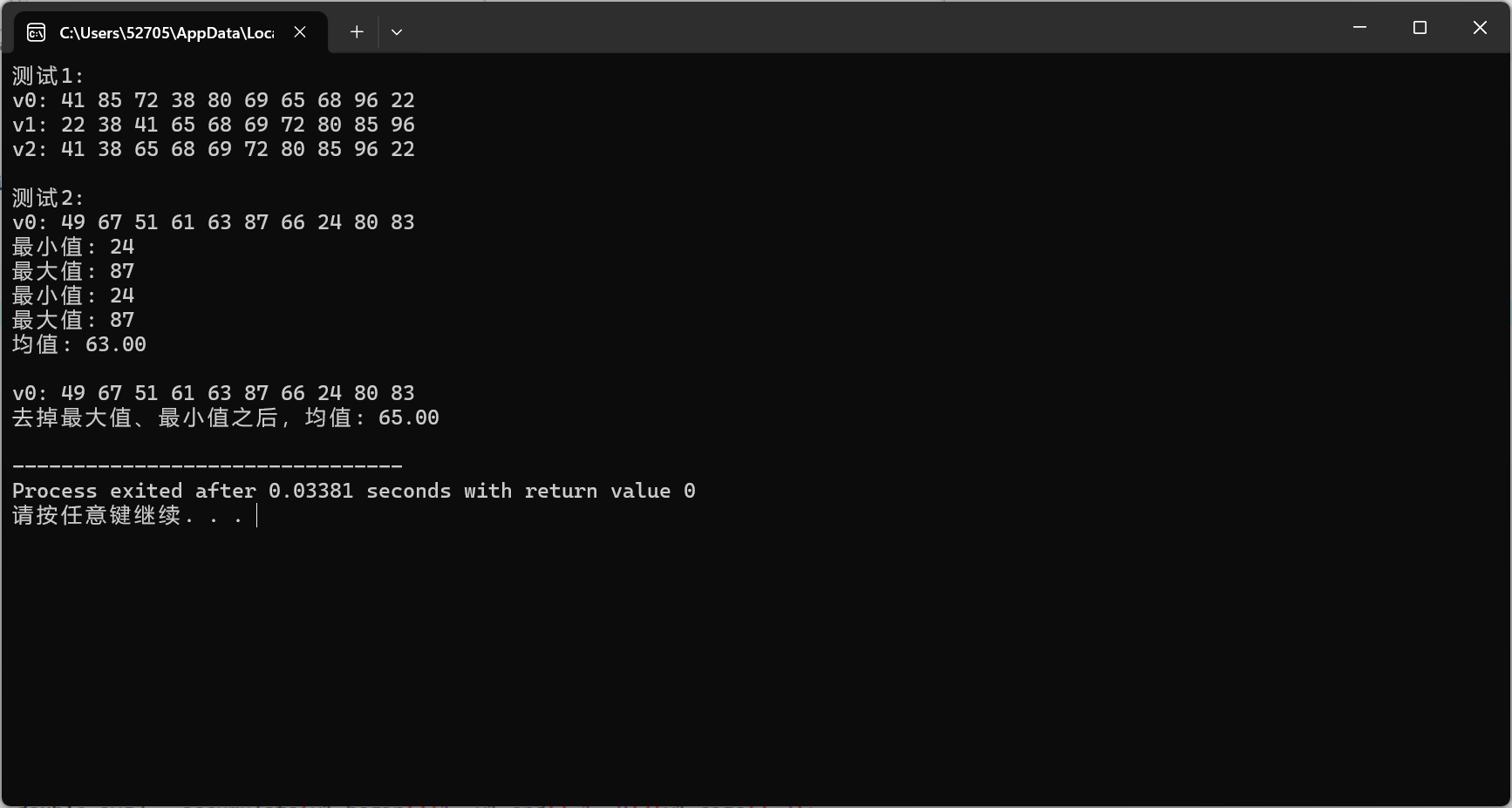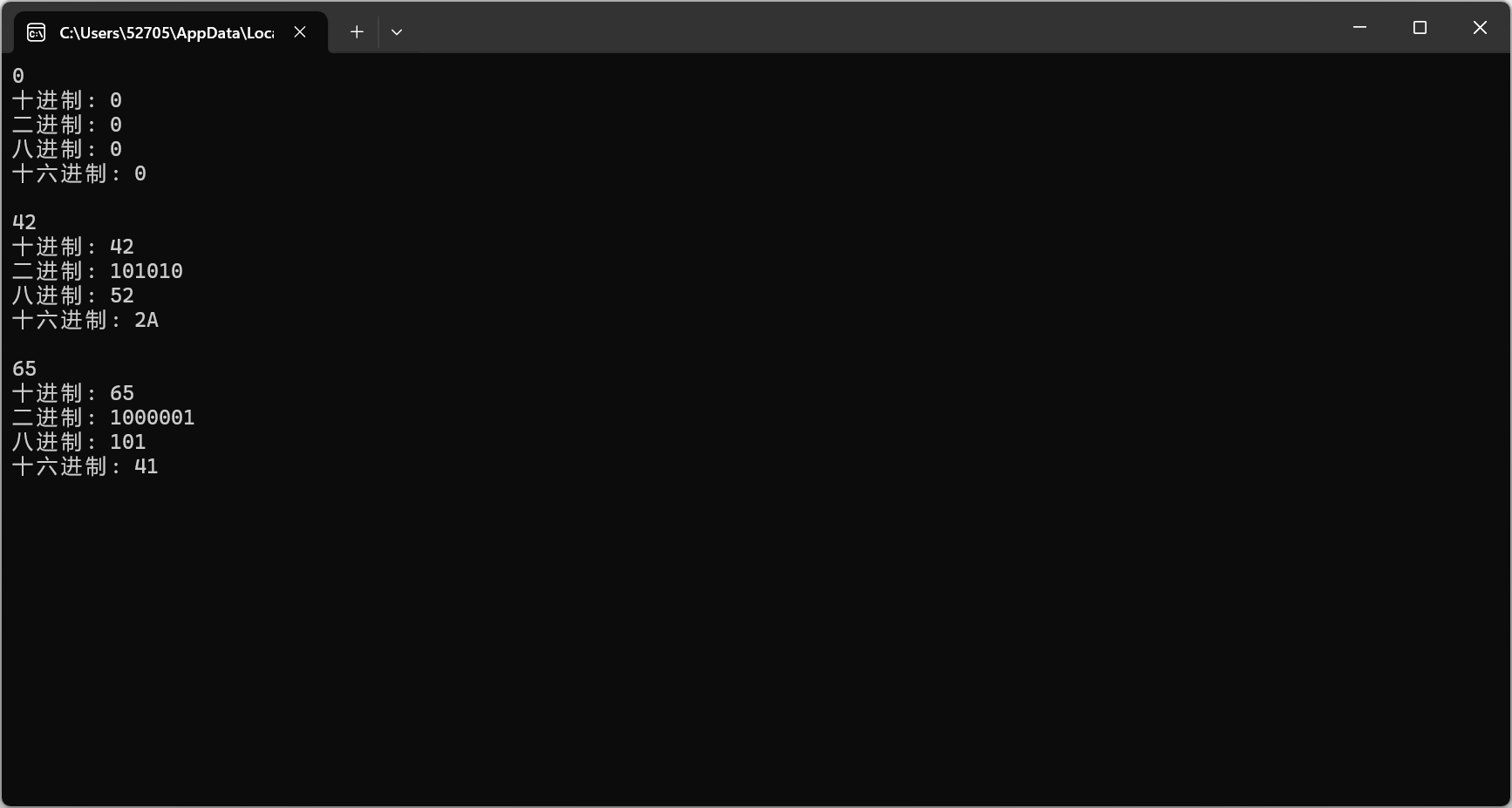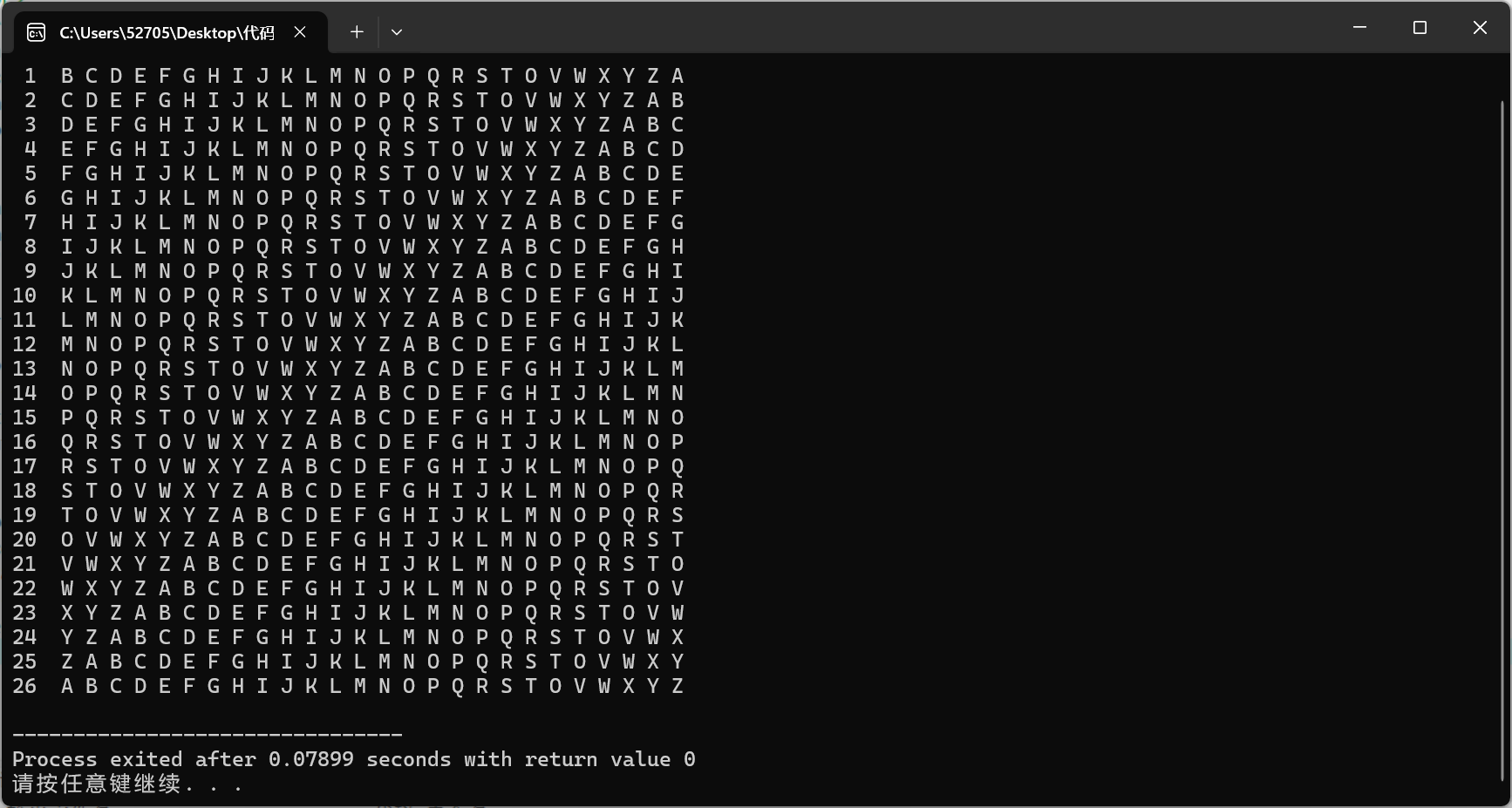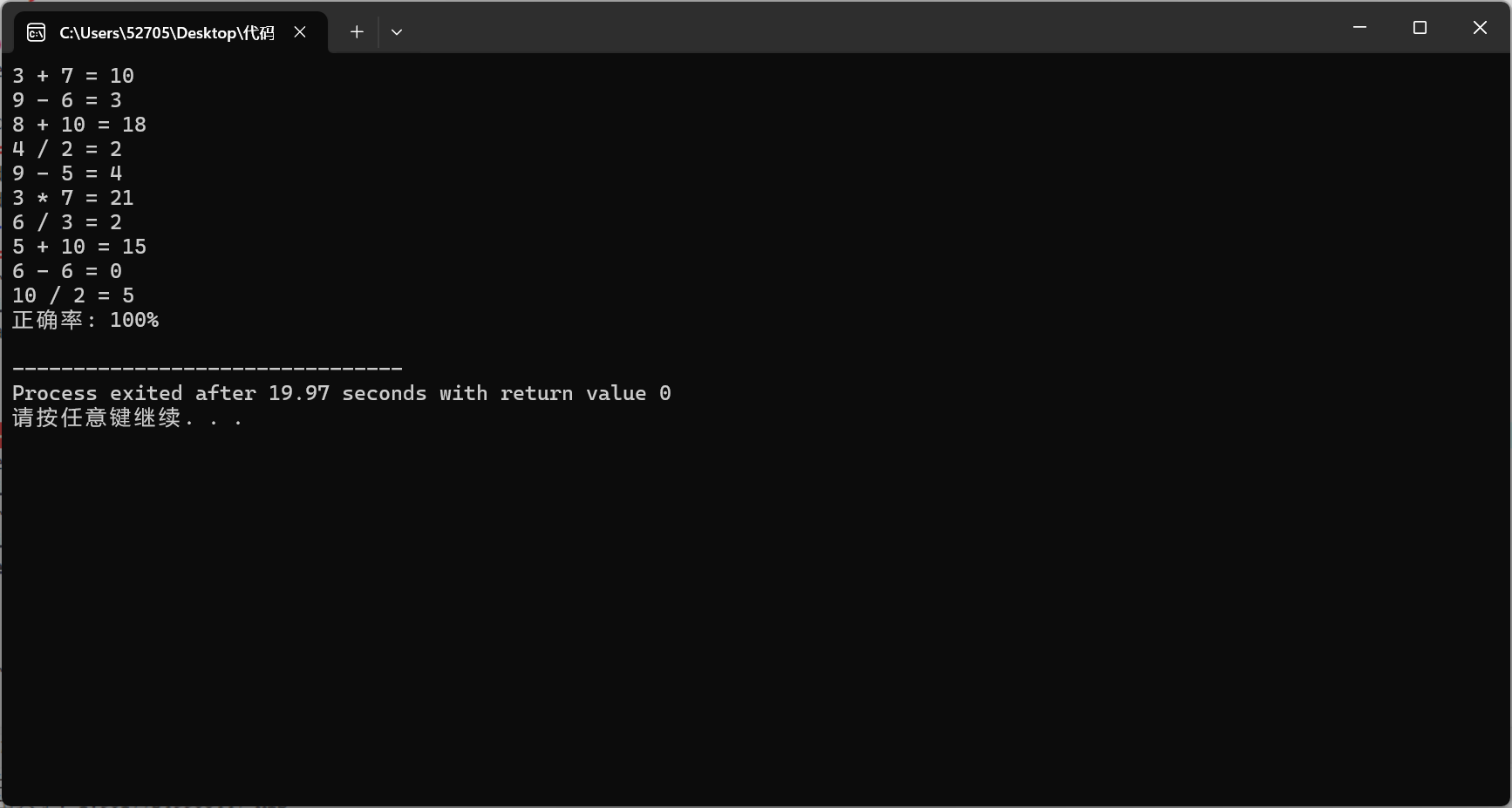c++实验1
实验1:

// 现代C++标准库、算法库体验 // 本例用到以下内容: // 1. 字符串string, 动态数组容器类vector、迭代器 // 2. 算法库:反转元素次序、旋转元素 // 3. 函数模板、const引用作为形参 #include <iostream> #include <string> #include <vector> #include <algorithm> using namespace std; // 声明 // 模板函数声明 template<typename T> void output(const T &c); // 普通函数声明 void test1(); void test2(); void test3(); int main() { cout << "测试1: \n"; test1(); cout << "\n测试2: \n"; test2(); cout << "\n测试3: \n"; test3(); } // 函数实现 // 输出容器对象c中的元素 template <typename T> void output(const T &c) { for(auto &i: c) cout << i << " "; cout << endl; } // 测试1 // 组合使用算法库、迭代器、string反转字符串 void test1() { string s0{"0123456789"}; cout << "s0 = " << s0 << endl; string s1{s0}; reverse(s1.begin(), s1.end()); // 反转指定迭代器区间的元素 cout << "s1 = " << s1 << endl; string s2{s0}; reverse_copy(s0.begin(), s0.end(), s2.begin()); // 将指定迭代区间的元素拷贝到指定迭代器开始的目标区间,并且在复制过程中反转次序 cout << "s2 = " << s2 << endl; } // 测试2 // 组合使用算法库、迭代器、vector反转动态数组对象vector内数据 void test2() { vector<int> v0{2, 0, 4, 9}; cout << "v0: "; output(v0); vector<int> v1{v0}; reverse(v1.begin(), v1.end()); cout << "v1: "; output(v1); vector<int> v2{v0}; reverse_copy(v0.begin(), v0.end(), v2.begin()); cout << "v2: "; output(v2); } // 测试3 // 组合使用算法库、迭代器、vector实现元素旋转移位 void test3() { vector<int> v0{0, 1, 2, 3, 4, 5, 6, 7, 8, 9}; cout << "v0: "; output(v0); vector<int> v1{v0}; rotate(v1.begin(), v1.begin()+1, v1.end()); // 旋转指定迭代器区间[v1.begin(), v1.end())之间的数据项,旋转后从迭代器v1.begin()+1位置的数据项开始 cout << "v1: "; output(v1); vector<int> v2{v0}; rotate(v2.begin(), v2.begin()+2, v2.end()); cout << "v2: "; output(v2); vector<int> v3{v0}; rotate(v3.begin(), v3.end()-1, v3.end()); cout << "v3: "; output(v3); vector<int> v4{v0}; rotate(v4.begin(), v4.end()-2, v4.end()); cout << "v4: "; output(v4); }

实验2:

#include <iostream> #include <vector> #include <string> #include <algorithm> #include <numeric> #include <iomanip> using namespace std; // 函数声明 // 模板函数声明 template<typename T> void output(const T &c); // 普通函数声明 int rand_int_100(); void test1(); void test2(); int main() { cout << "测试1: \n"; test1(); cout << "\n测试2: \n"; test2(); } // 函数实现 // 输出容器对象c中的元素 template <typename T> void output(const T &c) { for(auto &i: c) cout << i << " "; cout << endl; } // 返回[0, 100]区间内的一个随机整数 int rand_int_100() { return rand() % 101; } // 测试1 // 对容器类对象指定迭代器区间进行赋值、排序 void test1() { vector<int> v0(10); // 创建一个动态数组对象v0, 对象大小为10 generate(v0.begin(), v0.end(), rand_int_100); // 产生[0, 100]之间的随机整数赋值给指定迭代器区间[v0.begin(), v0.end())内的每个数据项 cout << "v0: "; output(v0); vector<int> v1{v0}; sort(v1.begin(), v1.end()); // 对指定迭代器区间[v1.begin(), v1.end())内数据项进行升序排序 cout << "v1: "; output(v1); vector<int> v2{v0}; sort(v2.begin()+1, v2.end()-1); // 对指定迭代器区间[v1.begin()+1, v1.end()-1)内数据项进行升序排序 cout << "v2: "; output(v2); } // 测试2 // 对容器类对象指定迭代器区间进行赋值、计算最大值/最小值/均值 void test2() { vector<int> v0(10); generate(v0.begin(), v0.end(), rand_int_100); cout << "v0: "; output(v0); auto iter1 = min_element(v0.begin(), v0.end()); cout << "最小值: " << *iter1 << endl; auto iter2 = max_element(v0.begin(), v0.end()); cout << "最大值: " << *iter2 << endl; auto ans = minmax_element(v0.begin(), v0.end()); cout << "最小值: " << *(ans.first) << endl; cout << "最大值: " << *(ans.second) << endl; double avg1 = accumulate(v0.begin(), v0.end(), 0)/v0.size(); cout << "均值: " << fixed << setprecision(2) << avg1 << endl; cout << endl; vector<int> v1{v0}; cout << "v0: "; output(v0); sort(v1.begin(), v1.end()); double avg2 = accumulate(v1.begin()+1, v1.end()-1, 0)/(v1.size()-2); cout << "去掉最大值、最小值之后,均值: " << avg2 << endl; }

实验3:

#include <iostream> #include <string> // 函数定义,判断字符串是否为回文,区分大小写 bool is_palindrome(const std::string& s) { size_t length = s.length(); for (size_t i = 0; i < length / 2; ++i) { if (s[i] != s[length - 1 - i]) { return false; } } return true; } int main() { std::string s; while(std::cin >> s) { // 多组输入,直到按下Ctrl+D或Ctrl+Z后结束测试 std::cout << std::boolalpha << is_palindrome(s) << std::endl; } return 0; }

实验4:

#include <iostream> #include <string> #include <stack> std::string dec2n(int x, int n = 2) { if (x == 0) return "0"; const std::string digits = "0123456789ABCDEF"; std::stack<char> remainderStack; while (x > 0) { remainderStack.push(digits[x % n]); x /= n; } std::string result; while (!remainderStack.empty()) { result += remainderStack.top(); remainderStack.pop(); } return result; } int main() { int x; while(std::cin >> x) { std::cout << "十进制: " << x << std::endl; std::cout << "二进制: " << dec2n(x) << std::endl; std::cout << "八进制: " << dec2n(x, 8) << std::endl; std::cout << "十六进制: " << dec2n(x, 16) << std::endl << std::endl; } return 0; }

实验5:

#include<iostream> #include<string> #include<vector> #include<algorithm> #include<iomanip> using namespace std; template<typename T> void output(const T &c); int main() { vector<char>v0{'a','b','c','d','e','f','g','h','i','j','k','l','m','n','o','p','q','r','s','t','o','v','w','x','y','z'}; vector<char>v1{'A','B','C','D','E','F','G','H','I','J','K','L','M','N','O','P','Q','R','S','T','O','V','W','X','Y','Z'}; cout << " "; output(v0); for(int i = 1;i<=26;i++) { vector<char>v2{v1}; cout <<setw(2) << i << " "; rotate(v2.begin(),v2.begin()+i,v2.end()); output(v2); } } template <typename T> void output(const T &c){ for(auto &i:c) cout << i <<" "; cout << endl; }

实验6:

#include <iostream> #include <cstdlib> #include <ctime> using namespace std; int main() { srand(time(0)); int a, b, user_answer, correct_answer; char op; int correct_count = 0; for (int i = 0; i < 10; ++i) { a = rand() % 10 + 1; b = rand() % 10 + 1; op = "+-*/"[rand() % 4]; if (op == '+') { correct_answer = a + b; } else if (op == '-') { if (a <b) { int temp = a; a = b; b = temp; } correct_answer = a - b; } else if (op == '*') { correct_answer = a * b; } else if (op == '/') { while (b == 0 || a % b != 0) { a = rand() % 10 + 1; b = rand() % 10 + 1; } correct_answer = a / b; } cout << a << " " << op << " " << b << " = "; cin >> user_answer; if (user_answer == correct_answer) { correct_count++; } } cout << "正确率: " << (correct_count * 10) << "%" << endl; return 0; }







【推荐】国内首个AI IDE,深度理解中文开发场景,立即下载体验Trae
【推荐】编程新体验,更懂你的AI,立即体验豆包MarsCode编程助手
【推荐】抖音旗下AI助手豆包,你的智能百科全书,全免费不限次数
【推荐】轻量又高性能的 SSH 工具 IShell:AI 加持,快人一步
· 被坑几百块钱后,我竟然真的恢复了删除的微信聊天记录!
· 【自荐】一款简洁、开源的在线白板工具 Drawnix
· 没有Manus邀请码?试试免邀请码的MGX或者开源的OpenManus吧
· 园子的第一款AI主题卫衣上架——"HELLO! HOW CAN I ASSIST YOU TODAY
· 无需6万激活码!GitHub神秘组织3小时极速复刻Manus,手把手教你使用OpenManus搭建本